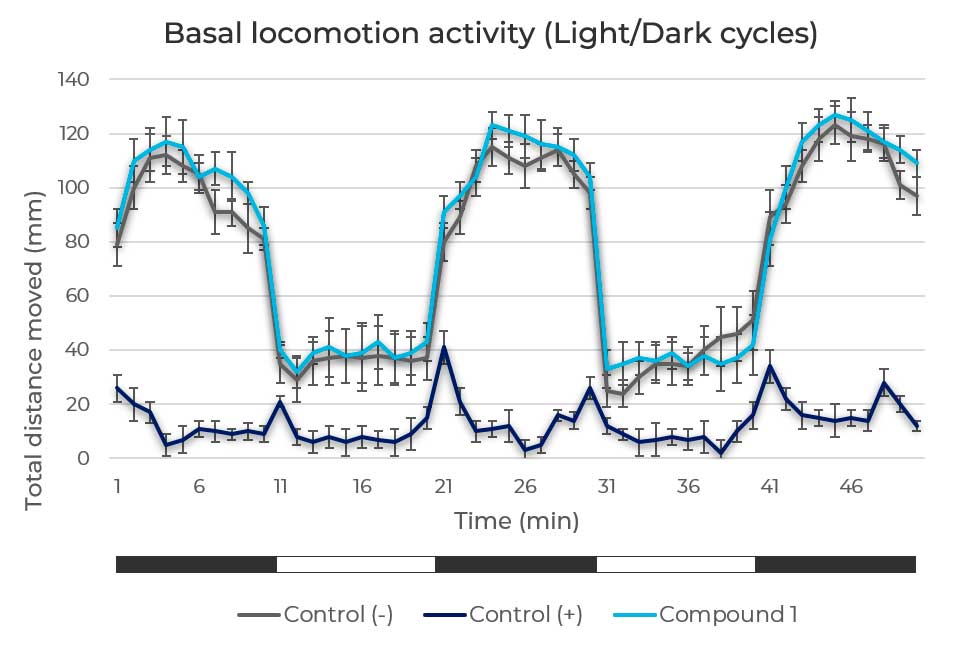 NeuroTox – Neurotoxicity Service
NeuroTox – Neurotoxicity Service
Exposure to some drugs might alter the normal activity of the nervous system and even cause irreversible damage to the nervous tissue. When evaluating neurotoxic effects, we differentiate between CNS side effects, referring to functional and transient alterations, such as sedation, and neurotoxicity itself considering neuronal loss or permanent structural changes. These adverse effects are widespread and amongst the most frequent reasons for drug attrition.
NeuroTox takes advantage of the high similarity between zebrafish and human nervous system structure and function to predict the harmful consequences of new compounds exposure or custom gene mutations on the nervous system.
 Figure 1. Conserved brain structures between zebrafish and humans.
Figure 1. Conserved brain structures between zebrafish and humans.
Advantages
Assessment of a wide myriad of behavioral phenotypes such as feeding, seizures, involuntary movement, sleeping, and addiction.
Customizable experimental design.
Evaluation of potential neurotoxicity protective candidates.
Simultaneous assessment of cardiotoxicity and hepatotoxicity through the service ZeGlobalTox.
Method description
Transgenic zebrafish larvae expressing green fluorescent protein (GFP) in a neuronal transgenic reporter are incubated with 1-5 concentrations of the compound of interest based on the previously determined BMD. According to the exposure timeframe, we would be able to measure:
- Neurotoxicity: 24 h exposure (from 96 to 120 hpf)
- CNS side effects: 3 h exposure (from 120 to 123 hours post fertilization, hpf)
Locomotor activity in response to light/dark cycles is monitored using the Daniovision™ device together with the Ethovision XT software (Noldus IT). Behavioral alterations are subsequently associated with specific drug-induced neuronal impact. Optionally, larvae can be then fixed and neuronal clusters observed to determine changes in neuronal number. In addition to basal locomotor activity, other behavioral responses such as seizures, thigmotaxis, and sedation are evaluated as CNS side effects.
Readouts
Determination of behavioral phenotypes:
- Changes in the basal locomotor activity
- Altered response to light stimuli
- Thigmotaxis (only with acute exposure)
- Habituation (only with acute exposure)
- Seizures (only with acute exposure)
- Neuronal survival (only with long exposure)
 Figure 2. General motor activity evaluation. Light/Dark locomotion pattern of zebrafish larvae in response to a negative control, to a neurotoxic agent (positive control), and a study compound that doesn’t produce neurotoxic effects on basal locomotor activity.
Figure 2. General motor activity evaluation. Light/Dark locomotion pattern of zebrafish larvae in response to a negative control, to a neurotoxic agent (positive control), and a study compound that doesn’t produce neurotoxic effects on basal locomotor activity.
 Figure 3. Convulsive behavior assessment. Maximum velocity and the number of angle turns of the larvae treated with vehicle (negative control), convulsive compound (positive control), and a study molecule that does not produce seizures in response to light flash.
Figure 3. Convulsive behavior assessment. Maximum velocity and the number of angle turns of the larvae treated with vehicle (negative control), convulsive compound (positive control), and a study molecule that does not produce seizures in response to light flash.
We'd like to hear from you
If you want more information about our NeuroTox
assay or have any other questions, please
contact our experts.
References
- Cornet C, Calzolari S, Miñana-Prieto R, Dyballa S, van Doornmalen E, Rutjes H, Savy T, D'Amico D, Terriente J. ZeGlobalTox: An Innovative Approach to Address Organ Drug Toxicity Using Zebrafish. Int J Mol Sci. 2017 Apr 19;18(4):864.
- Kokel D, Bryan J, Laggner C, White R, Cheung CY, Mateus R, Healey D, Kim S, Werdich AA, Haggarty SJ, Macrae CA, Shoichet B, Peterson RT. Rapid behavior-based identification of neuroactive small molecules in the zebrafish. Nat Chem Biol. 2010 Mar;6(3):231-237.